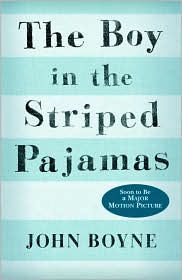Lately I have heard a lot of talk about The Boy in the Striped Pajamas | John Boyne. This is partly because the movie just came out. My cousin Chase loaned the book to my sister and I so I wanted to try and read it before he heads back for his last semester of college.
My senior year of high school I was fortunate enough to go on the “Europe Trip” with my school and we went to Germany for one of our stops. While in Germany we went to visit Dachau. It was one of the first concentration camps in Nazi Germany, but not as well known as Auschwitz though that doesn’t make it any less of a horrific place.
Upon visiting the concentration camp I was able to see where these people were forced to live cramped into a giant room with hundreds of bunk beds and lockers. We were even shown the crematorium; and never before had I understood what people meant when they said they could feel heaviness in the air until I entered that room. You could feel the oppression and the hate permeating every bit space inside.

For me the Holocaust is one of the hardest parts of history to comprehend, because of the hate and deceit that radiated from the Nazi soldiers, and for what? Dachau, not unlike many other concentration camps, greeted each new resident with the lie “Arbeit Macht Frei” (or work will make you free).
These are the things that immediately flood my mind when reading a book about this time period.
As I started this book, I learned that this book is written for young people, naturally there is a simplicity and easiness to the narrative. I find the point of view in which the story is portrayed especially interesting; it is very rare to observe the events of the holocaust through the eyes of a child.
Based on the title of the book, I was a bit startled to find that the boy in the striped pajamas (or uniform) is not introduced until almost half way through the story. The firs half of the story allows you to truly get to know Bruno, the son of a Commandant in the Nazi army. His curiosity about all things and naïve sense of the world around him allows him to befriend a young Jewish boy through the fence of a concentration camp located next to his house.
Because I don’t want to ruin this story for anyone I won’t go any further, but I do highly recommend this read to everyone. Since it is only 215 pages it doesn’t take much time to read but it is definitely worth it.


I really liked (i feel like love is a weird thing to say here since it’s a sad story) the Boy in the Striped Pajamas. I loved the point of view that it came from and I have not heard of a book from that era from a child in the middle of the bad side’s point of view. World War II stories I have always been really drawn to and the line (not word for word) from the book that really hit me was when I think one of Bruno’s parents told him the people on the other side of the fence weren’t people. That people really thought that way and could see other human beings like them as not worthy to walk the same earth they do. In the back of the book there is a interview with John Boyne, the author, and he draws attention to the many people who sat back and let the Nazis do this to the Jewish people. How they were silent (I forget the exact wording used) enablers of the attempt to wipe out the Jewish population in Europe, and how in this day we look back on it with such horror and don’t see how that could have happened – what would you have done if you weren’t Jewish and lived in that time? Would you have sat back and let it happen? Would you have tried to protect the innocent lives of a Jewish family somewhere in your house? Would you have been a radical who blatantly obsessed it and therefore risked your life? One of my favorite books on WWII from growing up was The Upstairs Room by Johanna Reiss about two sisters who are hidden together in….obviously the upstairs room a family’s home – just in case you wanted to know. 🙂
I recommend re-reading both the Upstairs Room and The Journey Back (the sequel). I did this a couple of years ago, and it’s amazing what emotions a child’s book can elicit in you as an adult.